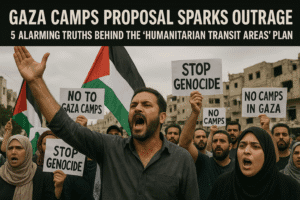Gaza Camps Proposal Sparks Outrage: 5 Alarming Truths Behind the “Humanitarian Transit Areas” Plan
A confidential $2 billion proposal—bearing the name of the U.S.-backed Gaza Humanitarian Foundation (GHF)—aims to build mass camps called “Humanitarian Transit Areas” inside and potentially outside Gaza. Described as “voluntary,” these facilities would house displaced Palestinians to “deradicalize, re-integrate, and relocate” them while replacing Hamas’ governance. The plan, reportedly discussed in the White House, stokes fears of forced displacement, echoing Trump’s earlier call to resettle Gaza’s 2.3 million people.
GHF denies authoring the proposal, calling it “theoretical,” yet its branding appears throughout the document. Critics warn the camps exploit a traumatized population enduring famine and bombardment, with one expert stressing “no voluntary displacement exists under such conditions.” The plan aligns with U.S.-Israeli efforts to sideline UN aid channels, despite GHF’s operations being linked to over 613 aid-point deaths. While stalled by funding shortages, the revelation deepens Palestinian anxieties about permanent exile and loss of autonomy.

Gaza Camps Proposal Sparks Outrage: 5 Alarming Truths Behind the “Humanitarian Transit Areas” Plan
A confidential proposal outlining vast camps for displaced Palestinians—dubbed “Humanitarian Transit Areas” (HTAs)—has ignited debate over Gaza’s future. While framed as voluntary safe zones, the plan raises profound questions about autonomy, displacement fears, and the power struggle to reshape post-war Gaza.
The Core Controversy
The $2 billion plan, bearing the name of the U.S.-backed Gaza Humanitarian Foundation (GHF), envisions camps inside and potentially outside Gaza. According to documents seen by Reuters, these HTAs would allow Palestinians to “temporarily reside, deradicalize, re-integrate and prepare to relocate.” Though GHF denies authorship, the plan explicitly aims to “replac[e] Hamas’ control over the population.”
Key tensions revealed:
- “Voluntary” vs. Reality: The proposal claims relocation would be optional, but experts note this ignores Gaza’s trauma. “There’s no voluntary displacement for people bombarded for two years and starved of aid,” says Jeremy Konyndyk (Refugees International).
- Echoes of February: The plan follows former President Trump’s call to “take over” Gaza and resettle its 2.3 million people—a statement that previously drew condemnation.
- Who’s Behind It?: Despite GHF/SRS denials, their names appear throughout the document. The disconnect fuels suspicions about hidden agendas.
The Geopolitical Subtext
The HTAs align with two U.S.-Israeli priorities:
- Bypassing UN Aid Channels: The GHF (funded by a recent $30M U.S. grant) is favored over UN agencies accused by Israel of allowing aid diversion—a claim Hamas denies.
- Undermining Hamas: Camps would sever civic ties to Hamas, acting as “deradicalization” hubs. Ismail Al-Thawabta (Hamas media office) calls GHF an “intelligence tool.”
Yet major hurdles exist:
- Funding & Feasibility: A source admits the plan stalled due to lack of financing. Banks like UBS reportedly refused to work with GHF.
- International Backlash: The UN labels GHF’s model “inherently unsafe,” citing 613+ deaths near its aid points since May.
The Human Dimension
Beyond politics, the proposal exposes Gaza’s humanitarian abyss:
- Camps as “Safe Havens”? Proponents argue HTAs offer escape from Hamas control. But with Gaza’s health ministry reporting 57,000+ deaths, 90% displacement, and famine, “safety” is relative.
- Scale of Displacement: One camp could hold 2,160 initially, but planners envisioned eight facilities for hundreds of thousands—a staggering logístical and ethical challenge.
- The Displacement Fear: Arrows pointing toward Egypt/Cyprus on proposal maps evoke traumatic historical exoduses. Even discussing such camps, experts warn, deepens Palestinian anxieties.
The Unanswered Questions
- Who Authored the Plan? GHF’s denial contradicts document branding, suggesting obscured origins.
- Is This “Voluntary” Viable? Coercion isn’t explicit, but survival instincts amid chaos complicate consent.
- What Replaces Hamas? The plan seeks to dismantle Hamas governance but offers no political alternative—only transitional control by a contested aid group.
The HTA proposal—whether defunct or dormant—reveals a stark vision for Gaza: one where population management supersedes self-determination. As Gaza’s suffering enters its 22nd month, the debate isn’t just about camps. It’s about whether Palestinians will have agency in their own future—or become subjects of a destabilizing experiment in social reengineering.
You must be logged in to post a comment.